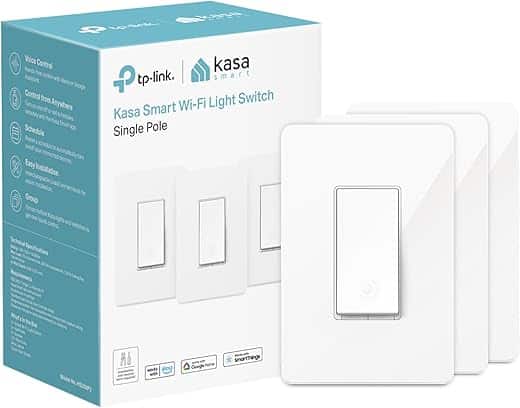What Are Smart Switches?
Smart switches are the modern-day solution to controlling your home’s lighting and energy usage seamlessly and conveniently. Unlike traditional switches that require manual operation, smart switches allow you to control your lights from anywhere—be it from the comfort of your couch, your office, or even while on vacation—using your smartphone or voice commands. This innovative technology not only enhances convenience but also contributes to energy efficiency and home security.
How Do Smart Switches Work?
Smart switches connect to your home Wi-Fi network, enabling communication between the switch and your smart devices. Once connected, users can manage their lighting through dedicated mobile apps or voice-activated virtual assistants like Amazon Alexa or Google Assistant. This connectivity allows for real-time monitoring and control, making it easy to adjust lighting based on your schedule or preferences.
Types of Smart Switches
Smart switches come in various forms, each designed to cater to specific needs and preferences. Below are some popular types:
1. Dimmer Switches
Dimmer switches allow you to adjust the brightness of your lights, creating the perfect ambiance for any occasion. Brands like Lutron Caseta and Philips Hue offer excellent dimmer solutions that can be controlled via their respective apps or through voice commands.
Example Products:
2. Programmable Timers
These smart switches let you set specific times for your lights to turn on or off, ensuring that your home is always well-lit when you need it. They can also help you save energy by automatically turning off lights when they’re not in use.
Example Products:
3. Occupancy Sensors
Occupancy sensors detect movement in a room and automatically turn lights on or off based on your presence. This feature is not only convenient but also enhances energy efficiency by ensuring that lights are only on when needed.
Example Products:
Benefits of Smart Switches
Switching to smart technology offers numerous benefits compared to traditional switches. Here are some key advantages:
Comparison Table of Popular Smart Switches
| Feature | Lutron Caseta | TP-Link Kasa HS200 | Wemo Light Switch |
|---|---|---|---|
| Type | Dimmer | Programmable Timer | Programmable Timer |
| Voice Control | Yes (Alexa, Google Assistant) | Yes (Alexa, Google Assistant) | Yes (Alexa, Google Assistant) |
| App Control | Lutron App | Kasa Smart App | Wemo App |
| Energy Monitoring | No | Yes | Yes |
| Scheduling | Yes | Yes | Yes |
Benefits of Energy Efficiency with Smart Switches
In today’s world, energy efficiency has become a crucial focus for both homeowners and businesses alike. Smart switches are at the forefront of this movement, offering innovative solutions that not only enhance convenience but also drive significant energy savings. Let’s dive deeper into the various benefits that smart switches bring to the table.
Reduced Energy Consumption through Automation
One of the standout features of smart switches is their ability to automate lighting usage. By connecting to your home Wi-Fi network, smart switches can be programmed to turn lights on and off based on your daily routines or even the time of day.
How Does Automation Work?
Setting Schedules for Lighting Usage
With smart switches, you can easily create schedules for your lights. This feature allows you to define specific times for lights to turn on or off, which can be adjusted according to your lifestyle.
Example of Scheduling Benefits
Energy-Saving Features: Dimming Capabilities
Another significant advantage of smart switches is their dimming capabilities. Dimming your lights can lead to substantial energy savings, as less energy is consumed when lights are not at full brightness.
Benefits of Dimming
Real-World Examples and Statistics
Energy Bill Savings
According to a study by the Energy Saving Trust, households that adopted smart lighting solutions, including smart switches, reported an average savings of up to 20% on their annual electricity bills.
Environmental Impact
Summary of Benefits
| Benefit | Description |
|---|---|
| Automation | Automatically turn lights on/off based on routines. |
| Scheduling | Set specific times for lights, reducing unnecessary usage. |
| Dimming Capabilities | Save energy and extend bulb lifespan with reduced brightness. |
| Cost Savings | Potentially lower energy bills by 20% on average. |
| Environmental Impact | Help reduce carbon footprint and conserve energy. |
Incorporating smart switches into your home or office is not just a trend; it’s a smart investment that pays off in energy savings, convenience, and environmental responsibility. Embrace the future of energy efficiency today!
How to Choose the Right Smart Switch
Choosing the right smart switch can elevate your home automation experience, providing convenience, energy savings, and enhanced control over your lighting. With so many options on the market, it can be overwhelming to find the perfect fit for your needs. In this guide, we’ll break down the essential factors to consider, along with specific product recommendations to help you make an informed decision.
Compatibility with Existing Home Systems
Before making a purchase, it’s crucial to ensure that the smart switch you choose is compatible with your current home automation setup. Consider the following:
Recommended Smart Switches for Compatibility
Ease of Installation
Installation complexity varies between models. Some smart switches can be set up by anyone, while others may require professional assistance. Here are the key points to consider:
User-Friendly Installation Options
Features to Look For
Smart switches come packed with features that enhance their functionality. Here are some key features to consider:
Feature-Rich Smart Switches
Budget Considerations
Smart switches can range from budget-friendly options to high-end models. Establishing a budget before shopping can help narrow down your choices. Here’s a breakdown:
Budget-Friendly Recommendations
| Brand/Model | Price Range | Features |
|---|---|---|
| Wemo Mini Smart Plug | $25-$30 | Voice control, no hub required |
| TP-Link Kasa Smart Dimmer Switch | $40-$50 | App control, energy monitoring |
| Lutron Caseta Wireless | $60-$80 | Compatible with multiple ecosystems, easy installation |
Popular Smart Switch Brands and Models
When it comes to choosing a specific model, here are some top-rated brands to consider:
Ultimately, selecting the right smart switch requires an assessment of your home’s current system, your installation preferences, desired features, and budget. With the right choice, you can enjoy the convenience and efficiency of smart lighting tailored to your lifestyle.
Maximizing Savings and Sustainability Through Smart Technology
In conclusion, smart switches are a game-changing solution for enhancing energy efficiency in our homes and workplaces. By allowing us to control our energy consumption with precision, they not only help reduce our utility bills but also promote a more sustainable lifestyle. The convenience of scheduling, remote access, and integration with smart home systems makes these devices an essential upgrade for anyone looking to optimize their energy use. We encourage you to consider transitioning to smart switches to reap the benefits of significant energy savings, increased convenience, and a commitment to sustainability. Let’s embrace the future of energy efficiency together!




Leave a Reply